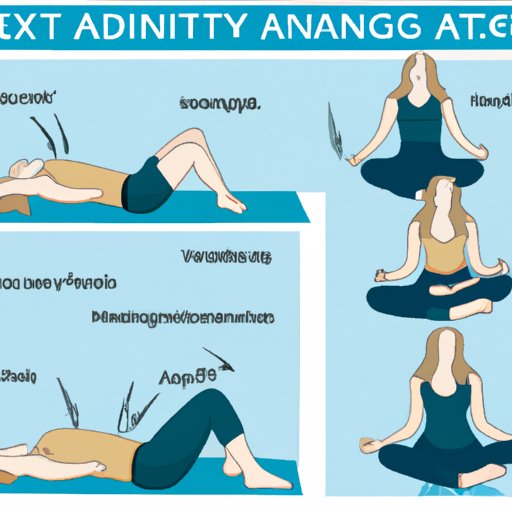Introduction
Anxiety attacks, also known as panic attacks, can be overwhelming and frightening experiences. They are characterized by sudden and intense feelings of fear and anxiety, often accompanied by physical symptoms such as rapid heart rate, sweating, and dizziness. Anxiety attacks can impact individuals’ daily lives, leading to lost productivity and disrupted routines. Therefore, it is important to know how to stop an anxiety attack when it occurs.
Deep Breathing Techniques
One of the common physical symptoms of an anxiety attack is breathing difficulties. During an anxiety attack, individuals tend to breathe rapidly, which can lead to hyperventilation and make the attack worse. Deep breathing techniques can help regulate breathing patterns and reduce symptoms of anxiety.
To practice deep breathing:
- Sit or lie down in a comfortable position.
- Place one hand on your chest and the other on your belly.
- Inhale deeply through your nose while counting to four.
- Hold your breath for a few seconds.
- Slowly exhale through your mouth while counting to six.
- Repeat this exercise for several minutes until you feel your breathing return to normal.
Grounding Exercises
Grounding techniques help individuals feel connected to the present moment and reduce feelings of anxiety and panic. These exercises can be done anywhere and can be tailored to meet an individual’s needs.
Examples of grounding exercises include:
- Focus on your surroundings. Name and describe everything you see, hear, touch, and smell.
- Use your senses. Hold a soothing object, such as a rock or piece of cloth, and focus on its texture and temperature.
- Practice relaxation techniques. Tense and relax each muscle group starting from your toes and working your way up to your head.
To incorporate grounding techniques during an anxiety attack:
- Pause and find a quiet place where you can focus on your breathing.
- Choose a grounding technique that works for you.
- Practice the exercise until you feel calmer and more in control.
Progressive Muscle Relaxation
Progressive muscle relaxation (PMR) is a relaxation technique that involves tensing and relaxing different muscle groups to reduce physical symptoms of anxiety. The process helps individuals learn to identify and release muscle tension, leading to decreased anxiety levels.
To practice PMR:
- Find a quiet and comfortable place to sit or lie down.
- Starting from your toes, tense your muscles while inhaling deeply for a few seconds.
- Exhale and release the tension in your muscles.
- Focus on the sensation of relaxation for a few moments before moving on to the next muscle group.
- Repeat the process, gradually working your way up to your head and neck.
Regular practice of PMR can help individuals better manage anxiety and reduce anxiety attacks.
Mindfulness Meditation
Mindfulness meditation is a relaxation technique that involves paying attention to the present moment without judgment. This approach to meditation emphasizes self-awareness and self-acceptance.
Research has found that mindfulness meditation can be particularly beneficial for individuals with anxiety disorders, including panic attacks. It can reduce anxiety levels and help individuals develop a sense of calm and well-being.
To practice mindfulness meditation:
- Find a quiet and comfortable place to sit.
- Close your eyes and focus on your breathing.
- Pay attention to the sensation of each breath, as it enters and exits your body.
- If your mind wanders, acknowledge the thought, and bring your attention back to your breathing.
- Continue this exercise for several minutes.
Mindfulness meditation can be a powerful tool in stopping an anxiety attack and improving overall mental health.
Get Moving
Physical activity is an effective way to reduce feelings of anxiety and improve mental health. Regular exercise can help regulate mood, increase self-esteem, and reduce stress levels.
Individuals experiencing anxiety attacks can benefit from different types of exercise, including:
- Cardiovascular exercise, such as running or cycling
- Yoga or Pilates
- Weightlifting or resistance training
- Walking or hiking
To get started with exercise:
- Choose an activity that you enjoy and that fits into your schedule.
- Start small, with short sessions 2-3 times a week.
- Gradually increase the frequency and duration of your exercise sessions.
- Be patient and give yourself time to adapt to the new routine.
Seek Professional Help
Anxiety disorders can be challenging to manage on your own, and it is essential to seek professional help if symptoms persist or interfere with daily activities. Different types of mental health professionals can provide treatment and support, including:
- Psychologists
- Psychiatrists
- Social workers
- Counselors
- Therapists
Therapy can help individuals with anxiety develop coping skills, manage symptoms, and prevent future anxiety attacks.
Conclusion
Stopping an anxiety attack involves using a variety of techniques to manage physical and psychological symptoms. Deep breathing, grounding exercises, PMR, mindfulness meditation, regular exercise, and seeking professional help are strategies that can help individuals reduce anxiety and improve overall mental health. It is important to remember that everyone’s experience with anxiety is unique, and finding what works best may take time and experimentation. If an individual continues to struggle with anxiety, it is essential to seek professional help.
